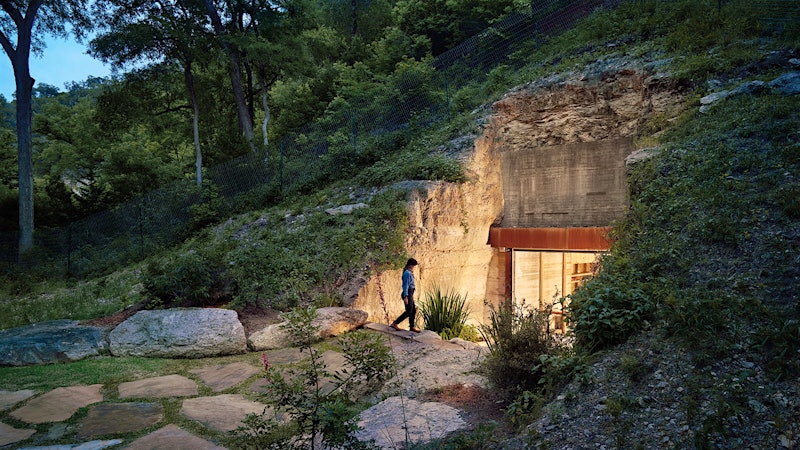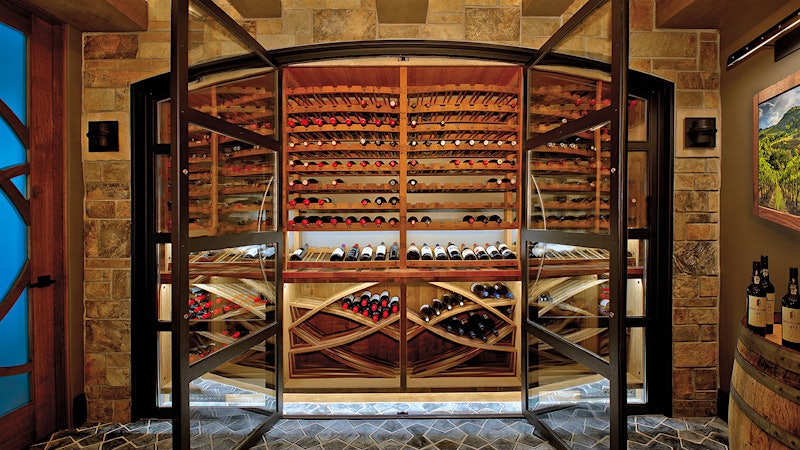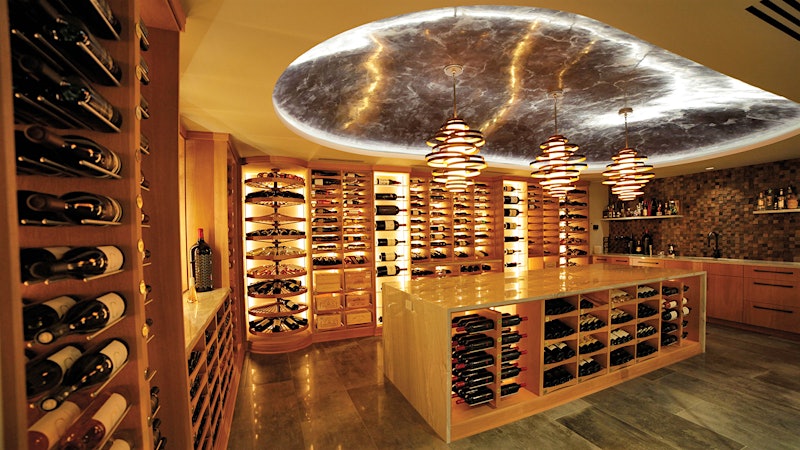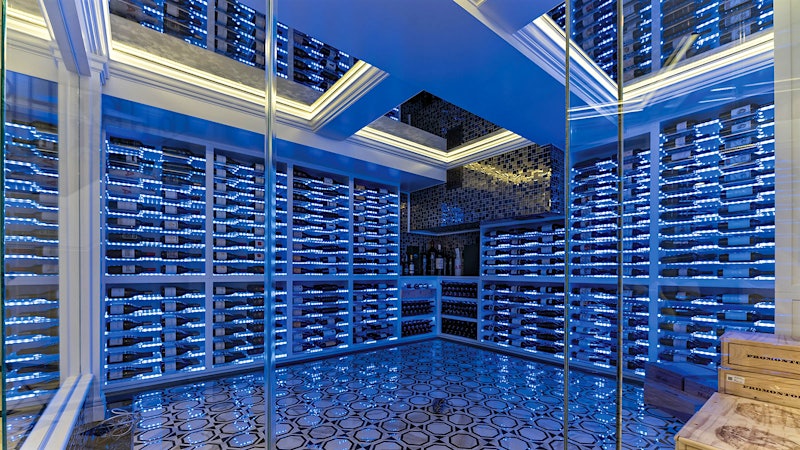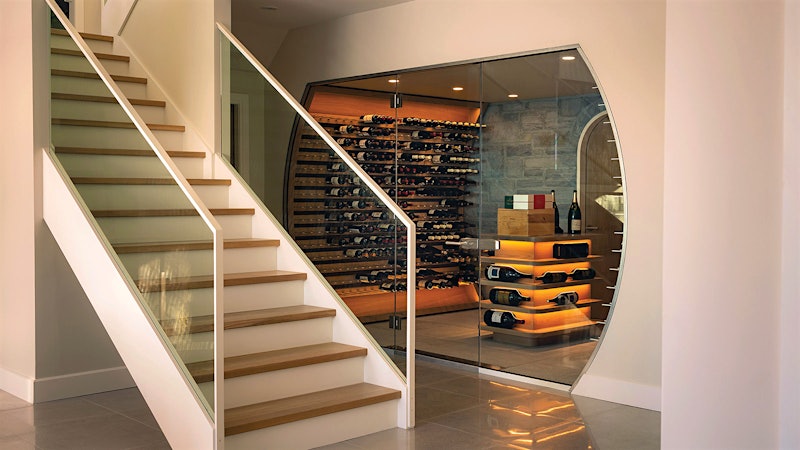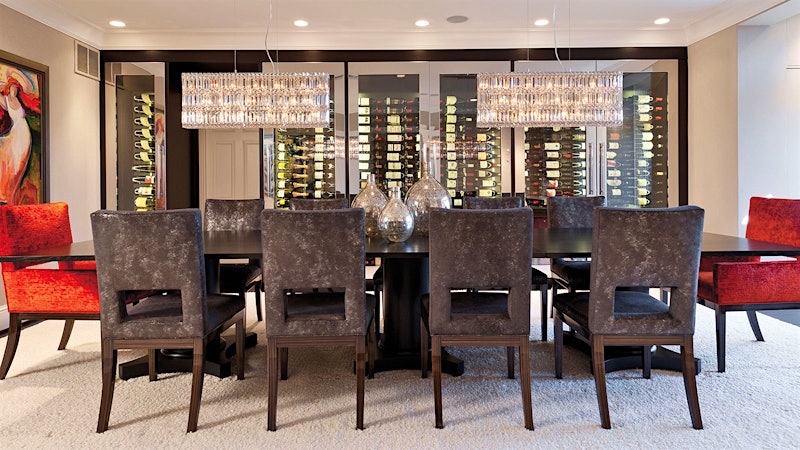Note: This article originally appeared in the July 31, 2017, issue of Wine Spectator.
It starts small. A couple of bottles stowed in a kitchen rack; a case for your birthday; maybe a splurge on an auction trophy. You taste with friends, broaden your palate, find yourself drawn to specific regions and producers. Before you know it, a closet is overflowing, but your collection is just getting started.
Dina Given, a writer and health-care executive living in Lebanon, N.J.—"farm-and-horse country," she says—began acquiring well-rated yet affordable wines in the mid-2000s, including a particularly memorable Schild Shiraz 2004 from Australia. But the size of the collection fast outstripped her ability to store it. "Originally, we kept the wines in boxes in our basement," she says. "Soon, the boxes were becoming really overwhelming, so I bought some cheap racks online, and all of a sudden we have walls full of racks."
Ultimately, a basement renovation provided the impetus to install a dedicated wine area. "We wanted a space to show off our bottles but also protect them," she says. "This collection is something we've been putting together for 10 years."
Mark DiPippa, an ad agency founder and creator of financial-literacy television program The Centsables, tells a similar story: "In the early 2000s, spending $50 on a bottle of wine was amazing to me. On my 50th birthday, I spent $10,000 on a '61 Petrus and a '61 Mouton-Rothschild and shared them with my father," he says. "My friends ask if I'm crazy, but I tell them these are experiences I'll have for the rest of my life."
This pivot from interest to passion marks the point of inflection from make-it-up-as-you-go-along wine storage in basements, boxes, nooks and crannies to a dedicated cellar that functions not only as housing for prized wines but as a domestic centerpiece for entertainment, relaxation and continuing education.
But for all the pleasures a home cellar can provide, it is not devoid of pitfalls. A temperature- and humidity-controlled space, often stocked with rare and expensive bottles in need of consistent care, the private cellar is an exercise in precision and discernment. Costs can be high, and losses—due to ill-considered construction or reckless purchasing—severe.

Foreknowledge is key. As with any significant investment, the risks of building a wine cellar can be mitigated by seeking the advice of experts and individuals who have gone down the path before you. For this guide, we spoke to cellar owners and designers about their experiences and the lessons they've learned. Consider their advice your own private consultation on the wine room of your dreams.
Think of a wine cellar as a room-size refrigerator: a sealed environment capable of being held at a constant temperature and humidity. If you happen to live over a network of readily accessible subterranean caves, all the better. Otherwise, creating your cellar will likely involve at least the installation of a dedicated cooling system and insulation of all surfaces (including the floor and walls). Then there's lighting, load-bearing shelving and more. Due to the complexity of the undertaking, setting up a cellar is beyond the scope of most do-it-yourselfers. Fortunately, there are many reputable firms across the country offering everything from in-depth consultations to full-service jobs comprising fabrication, delivery and installation.
Jim Cash, founder of Revel Custom Wine Cellars in East Lansing, Mich., got his start in the sector by designing his own home cellar. A veteran of the construction industry, he leverages his building and business credentials to bridge the gap between the personal tastes of collectors and the design puzzle presented by the demand for secure wine storage.
Cash says Revel rarely bids on jobs. Clients come primarily via referrals, with an existing sense of the firm's aesthetic; some even approach him prior to the construction of the home that will house the cellar. Things get personal fast.
"We have a discussion about what they collect, and then customize the cellar to the specific situation," Cash explains. "The goal is to match the cellar to the personal aesthetic of the customer." Even a client's height is taken into account: "I ask them how tall they are so I know how high I can do cabinetry without them needing a step stool or a ladder."
One of Cash's major customizations was for a collector based in Melbourne, Australia, who was drawn to the firm's trademark rotating Revel-ution wine panels. In the midst of a home renovation with an Italian interior design firm, the client requested that a supersized version of the storage system be constructed, with the standard steel racking dowels replaced by burnished copper versions to match his new countertops and light fixtures. Revel complied, custom-plating thousands of the dowels with antiqued copper and shipping the whole piece Down Under for installation.
Typically, however, a collaboration is hatched closer to home. Collector Harold Jablon was three revisions deep into a cellar blueprint with an Atlanta-based designer when he met contractor Ruben Calleiro at a charity event at Jablon's beach home in Charleston, S.C. The two began to discuss wine, and Jablon showed Calleiro the room he saw housing his yet-unrealized cellar.

"Ruben stood there for about 20 minutes while I described what I wanted," Jablon says. "He said, ‘I can do it—and I can make it 30 percent bigger and save you $10,000.' I said, ‘When can you start?'"
Calleiro worked out of the house's garage, fabricating the 800-bottle cellar over the course of three months. He created shelving from locally sourced cypress, hand-sanded the pieces and left the materials unfinished to preserve the natural beauty of the wood. The floor is ceramic tile that resembles wood but provides better insulation—a must for cellar not located below grade. "Ruben's a true craftsman," says Jablon. "He put his heart and soul into it."
Dina Given, on the other hand, spoke to several general contractors before settling on Joseph & Curtis Custom Wine Cellars in Mountainside, N.J., to create her cellar. "We weren't getting a lot of confidence from basement contractors that they would be able to build the wine cellar we wanted," she says. "A lot of them said they could do it but were proposing things that felt pretty basic."
After some research, Given called in Joseph & Curtis for a consultation. "They got what I wanted immediately," she says. "Their first design was perfect. I said, ‘That's it, you got it.'"
Given wanted a space she could spend time in without freezing. "A lot of wine rooms I've been in, the whole place is refrigerated," she says. "We didn't want to wear coats when we came in to have a glass of wine."

Designed as a wine wall, the cellar displays bottles behind glass, keeping the controlled storage space separate from the sitting area. The collection holds more than 700 bottles. Locally sourced elements are integrated into the structure; the cellar is framed out of reclaimed wood from an old tobacco barn in the area. "It's modern but has some rustic elements to it," she says.
DiPippa's cellar in Huntington, N.Y., was born from a business plan he developed in 2001 to create an Old World–style wine shop, bistro and fine-dining restaurant combo to be called Claret House. When New York building regulations forbidding such hybrid enterprises quashed his plans, he transferred his vision to his private cellar. "The space for the cellar was originally a 2,000-square-foot finished basement with a playroom and a gym with a golf net," DiPippa explains. But there was one issue with this otherwise ideal location: "I had to make a deal with my daughter, who was 9 or 10 at the time, to convert her play area into my wine cellar," DiPippa says with a laugh. "She got my old 10-by-10 wine room, and I got my cellar."
The space delivers the Old World ambience DiPippa desired, with travertine floors, an arched entryway with a custom-made iron gate, and walls composed of fieldstone. The racks were sourced from redwood, stained a dark walnut and lacquered. Building took six months. "I went through 1,000 pictures of wall-sconce lighting alone just to get the cellar to look exactly like what was in my mind," DiPippa says.
Capturing a sense of place was equally important to Kevin Theroux, an orthodontist from Greenwood Village, Colo., whose passion for wine stemmed from a love of international travel. Trips with his wife, Christine, to France, Italy, Spain, Australia and South Africa generated a collection of bottles meant to evoke memories of their time abroad.
Theroux shuns retail, preferring to buy wine while in-country. "Even many years later, drinking a bottle of wine brings back memories of the winery itself," he says. "Walking the vineyards, meeting the winemakers, cellar tastings, the particular weather or scenery. One of my favorite things that collecting and drinking wine offers is that feeling of connection."
Preserving this link to his wines' origins factored into the cellar Theroux commissioned from Denver-based designer Darryl Hogeback, whose firm, Savanté Wine Cellars, specializes in expert woodwork. "As an orthodontist, I measure success and failure in tenths of millimeters, and I wanted a craftsman who had the same micro-attention to detail," Theroux says.
Drawing on his love of Bordeaux, Theroux purchased several wooden barrels from a cooperage he'd visited in the region and asked Hogeback to incorporate them into the cellar as storage bins. The decanting area holds a photo of the Abbey of Sant'Antimo in Tuscany, a beloved biking spot of Theroux's.
Even the door to the cellar is endowed with terroir: "Christine and I found really amazing 19th-century pewter door hardware at a market in Provence," he says. "It actually came off an old barn." Unable to fit the hardware to a standard doorframe, Hogeback fabricated a custom walnut-and-glass door to accommodate it. Sometimes it takes an expert touch to bring a treasured memory home.
The road from vision to execution is not always so smooth. Many designers craft cellar parts at their workshops and ship them complete to the collector's address for installation. Maneuvering these ungainly pieces down stairwells and around corners can create challenges in the last mile.
When Cash was working on his own cellar—"Revel cellar No. 1," he says—the lazy Susan wine wheel he'd crafted wouldn't fit through the door to his wine room. Now he provides clients with a list of each large piece and its dimensions, requiring that they sign off on the order and ensure an accessible pathway from moving truck to cellar.
Savanté's Hogeback often encounters rooms set aside as cellar spots that are ill-suited to the task. "The builder or a remodeler would [then] have to come in and prep the space," he says. "This becomes a major cost." Other potential snags are less obvious. Hogeback cautions against using certain stains and finishes on racking components, since volatile organic compounds released by these substances can infiltrate corks and ruin wine. Cellar lighting should emit no UV rays, which could damage fragile liquid and labels. Moisture barriers should be placed behind all insulation, and moisture-resistant drywall, such as purple board, must be used in place of standard paper-coated surfaces, which can promote mold and mildew growth.
But the make-or-break consideration for many is price. Wine collecting is an expensive hobby, and reliable and attractive in-home bottle storage is no different. "Even if the client is fabulously wealthy," says Cash, "they usually inquire about cost up front."
One rule of thumb, cited by Cash, is to estimate the cost of the wood at around $45 per bottle. Curtis Dahl of Joseph & Curtis backs up this figure but cautions that the bespoke work his company is known for makes every project unique. "We are a very custom firm," Dahl says in an email. "We not only build but also do 100 percent of the design and fabrication, [so] each job is different."
Not surprisingly, the more customization a client wants, the more expensive a cellar will be. "So much depends on the efficiency of design," says Cash. "How efficiently our cabinetry arrays within the space, the wood species used. For example, there's a lot demand for walnut right now, which has a 15 percent premium versus mahogany." Racking can amount to roughly 70 percent of the cost of the cellar, so selection of materials is vital in estimating the bill for a project.
Before diving in, consider the ongoing costs of cellar ownership, such as insurance, electricity use and cooling-system maintenance and periodic replacement. It all adds up. But if you think of a cellar as a means of protecting your wine investment, not to mention a rewarding extension of your passion for wine over the course of decades, the hefty outlay begins to make sense.
What's in Their Cellars?
Mark DiPippa
Location: Huntington, N.Y.
Occupation: Advertising executive and television-show creator
Number of bottles: 750
Favorite producers: Caymus, Quintarelli
Notable wines: Pol Roger Reserve Champagne (salmanazar); Ornellaia 1999 (double magnum); Castello Banfi Centine 2006 (methuselah); Château Haut-Brion 1995 (magnum); Château Lafite Rothschild 1995; Château Latour 1999; Château Margaux 1999
Harlod and Irene Jablon
Location: Charleston, S.C.
Occupation: Dentist
Number of bottles: 800 in cellar; 400 off-site
Wine Spectator Wines of the Year: Casa Lapostolle Clos Apalta 2005; Clos des Papes Châteauneuf-du-Pape 2005; E. Guigal Châteauneuf-du-Pape 1999; Shafer Relentless 2008; Taylor Fladgate Vintage Port 1994; Fonseca Vintage Port 1994
Other notable wines: Château Haut-Brion 1975, Château Latour 1980, Château Margaux 1983, Château Mouton-Rothschild 1983 and 2001, Taylor Fladgate Vintage Port 1985 and 2007, Opus One 1999
Dina Given
Location: Lebanon, N.J.
Occupation: Pharmaceutical executive and fiction writer
Number of bottles: 800
Birth-year wines: Château Pontet-Canet 2005 and Joseph Phelps Insignia 2007, for children when they turn 21
Notable wines: Penfolds Grange 2001 and 2008, Casanova di Neri 2001, Harlan Estate 2012, Schild Shiraz 2004
Kevin Theroux
Location: Lone Tree, Colo.
Occupation: Orthodontist
Number of bottles: 700
Prized bottles: Château Lafite Rothschild 2003, Opus One 2001
Large-format bottles: Château Kirwan 1996 (methuselah), Pelissero Nubiola 2011 (jeroboam), Col d'Orcia Poggio al Vento Riserva 2006 (magnum)
Photo Gallery
Want to get the latest news on collectible wines, cellaring and the auction market? Sign up for Wine Spectator's free Collecting e-mail newsletter and get a new top-rated wine review, collecting Q&As and more, delivered straight to your inbox every other week!







